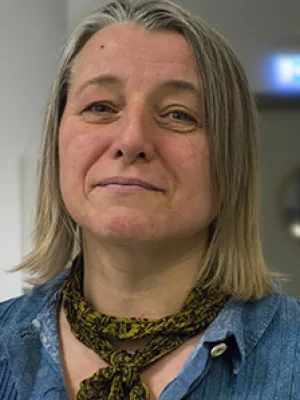
Charlotte Østergaard
Doktorand

Co-costuming as an orientation towards spaces of in-betweenness : Transformative co-wearing and co-locomoting encounters in between places and spaces
Författare
Summary, in English
This paper derives from the twelve-hour costume-based performance Community Walk that locomoted through the central area of Copenhagen on June 29, 2020. The focal point of Community Walk was a bright yellow costume that physically connected two wearers. In Community Walk I, the researcher and costume designer, placed myself ‘in the center’ of the co-wearing encounter. For twelve hours I co-wore the costume with twelve different co-wearers – one hour with each of the twelve participating co-wearers.
In Orientation Matters Sara Ahmed write that ‘bodies as well as objects shape though being orientated towards each other. An orientation that may be experienced as the cohabitation sharing of space’ (Ahmed, 2010:245). This suggest that it is through the object (the costume) that the co-wearers are orientated towards each other ¬– for example, exploring that when one wearer stretches the costume-material this movement will affect the movement of the co-wearer. Hence, in navigating/negotiating different ways of co-inhabiting and co-wearing the costume a temporal shared space is created between the wearers. Ahmed continues ‘if orientation affects what bodies do, then they also affect how space take shape around certain bodies’ (Ahmed, 2010:250). This indicates that the costume shapes the co-wearers interconnectedness, as well as, that the costume shapes the ‘queered entity’ (the entanglement of the wearers and the costume) in the urban environment. Hence, as ‘queered entity’ the co-wearers had to navigate/negotiate through urban environment.
In Vibrant Matter – A Political Ecology of Things Jane Bennett advocates that there is an ‘ethical task […] to cultivate the ability to discern nonhuman vitality’ (Bennet, 2010:14) by ‘affecting and being affected by other bodies’ (Ibid, p. 21). This suggest that the stretchy costume-materiality including the 1,5 meters long connecting part of the costume invited the co-wearers to affect, to be affected and to tangle with each other. Additionally, as a ‘queered entity’ orientated the co-wearers attention towards the urban environment that invited the co-wearers to tangle with other objects like trees, columns, lampposts, and the wind - offering urban/nature elements another kind of agency than in their daily life. In the willingness to ‘make kin’ (Haraway 2017) transformed the co-wearers orientation/relationship to each other and in specific situations transformed the co-wearers orientation/relationship towards to urban environment by entangling with specific urban/nature elements.
Building on Ahmed, Bennet and Haraway, I, in this paper, will discuss how the co-costumed encounters of Community Walk oriented the co-wearers multiple directions towards spaces of ‘in-betweenness’.
In Orientation Matters Sara Ahmed write that ‘bodies as well as objects shape though being orientated towards each other. An orientation that may be experienced as the cohabitation sharing of space’ (Ahmed, 2010:245). This suggest that it is through the object (the costume) that the co-wearers are orientated towards each other ¬– for example, exploring that when one wearer stretches the costume-material this movement will affect the movement of the co-wearer. Hence, in navigating/negotiating different ways of co-inhabiting and co-wearing the costume a temporal shared space is created between the wearers. Ahmed continues ‘if orientation affects what bodies do, then they also affect how space take shape around certain bodies’ (Ahmed, 2010:250). This indicates that the costume shapes the co-wearers interconnectedness, as well as, that the costume shapes the ‘queered entity’ (the entanglement of the wearers and the costume) in the urban environment. Hence, as ‘queered entity’ the co-wearers had to navigate/negotiate through urban environment.
In Vibrant Matter – A Political Ecology of Things Jane Bennett advocates that there is an ‘ethical task […] to cultivate the ability to discern nonhuman vitality’ (Bennet, 2010:14) by ‘affecting and being affected by other bodies’ (Ibid, p. 21). This suggest that the stretchy costume-materiality including the 1,5 meters long connecting part of the costume invited the co-wearers to affect, to be affected and to tangle with each other. Additionally, as a ‘queered entity’ orientated the co-wearers attention towards the urban environment that invited the co-wearers to tangle with other objects like trees, columns, lampposts, and the wind - offering urban/nature elements another kind of agency than in their daily life. In the willingness to ‘make kin’ (Haraway 2017) transformed the co-wearers orientation/relationship to each other and in specific situations transformed the co-wearers orientation/relationship towards to urban environment by entangling with specific urban/nature elements.
Building on Ahmed, Bennet and Haraway, I, in this paper, will discuss how the co-costumed encounters of Community Walk oriented the co-wearers multiple directions towards spaces of ‘in-betweenness’.
Avdelning/ar
- Lärare (Teaterhögskolan)
Publiceringsår
2022
Språk
Engelska
Dokumenttyp
Konferensbidrag: abstract
Ämne
- Performing Arts
- Design
Nyckelord
- Costume design
- Co-wearing
- Artistic research
- Costumed perfomance
Conference name
International Federation of Theatre Research
Conference date
2022-06-20 - 2022-06-24
Conference place
Reykjavik, Ireland
Status
Published
Projekt
- Crafting material bodies - ethical dilemmas of co-creative costume processes